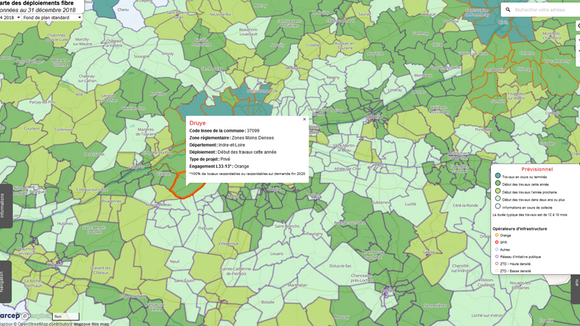Today, Arcep is publishing its scoreboard for the fixed broadband and superfast broadband market – rollouts and subscriptions – in France at the end of June 2019. The results for this quarter confirm the ongoing increase in FttH subscription numbers and rollouts.
SUBSCRIPTIONS: now more than 10 million superfast access lines in use, thanks to ongoing progress for FttH/B
- Over the course of Q2 2019, the number of superfast broadband subscriptions (maximum download speed equal to or faster than 30 Mbit/s) increased by 520,000 to reach 10 million, or an additional 2.2 million subscriptions year on year (YoY), versus an increase of 1.7 million one year earlier. As a result, as of 30 June 2019, more than a third of all internet subscribers in France had a superfast access line.
- Virtually the entirety of this quarterly growth is due to an increase in the number of subscriptions to fibre to the home/building (FttH/B) plans, which rose by 495,000 compared to the previous quarter and so accounting for more than 90% of the increase in superfast access subscriptions. As of 30 June 2019, the number of end-to-end fibre access lines totalled 5.8 million, which is 1.9 million than the year before.
- In total, 47% of all premises eligible to subscribe to a superfast access plan were subscribing to such a plan in Q2 2019, which marks a five-point increase YoY.
- The total number of broadband and superfast broadband subscriptions stood at 29.4 million at the end of Q2 2019, which marks an increase of 90,000 over the previous quarter and of 690,000 year on year (+2.4%).
ROLLOUTS: progressing at a faster pace, but need to accelerate further still
Over the past four quarters, 3.79 million additional premises have been passed for FttH, of which 1.13 million in Q2 2019, or around 37% more than in Q2 2018 – making it the strongest quarterly growth to date.
- As of 30 June 2019, 15.58 million premises were eligible to subscribe to an FttH access service, or 32% more than one year earlier.
- The pace of FttH rollouts in areas covered by public-initiative rollouts increased significantly during the quarter, with an additional 323,000 additional premises passed in Q2 2019. The overall rate of line sharing also showed a marked increase this quarter, rising to 44%. It nevertheless remains far below the rate in areas covered by public-initiative rollouts where it stands at around 90%.
- In total, at the end of Q2 2019, 21.6 million households in France were able to subscribe to a superfast internet access service, all technologies combined, including 15.4 million households located outside of very high-density areas.
- FttH rollout data have been updated on the cartefibre.arcep.fr website and in the Open Data made available by Arcep.
Monitoring the legally binding FttH rollout commitments that operators have made in those parts of the country where the Government has issued a call for investment letters of intent (called "zones AMII" in French).
In accordance with Article L. 33-13 of the French Postal and Electronic Communications Code (CPCE), Arcep is responsible for monitoring Orange and SFR’s compliance with the obligations they made.
At the end of Q2 2019, around 55% of the premises in the municipalities where Orange made rollout commitments, and 44% of those where SFR has made commitments have been passed for fibre. Operators will need to step up the pace of their deployments if they are to meet their targets on time.
N.B.: the first deadline is a commitment to have at least 92% of the premises passed by the end of 2020, with the remaining being passed “on request”.
Tracking FttH rollouts
cartefibre.arcep.fr allows users to obtain fibre coverage information on individual buildings, and so to track the progress of FttH rollouts in a detailed fashion. The maps also provide a snapshot of rollout forecasts, which means users can see the expected timeline for fibre rollouts in a given municipality.
Associated documents
- Broadband and superfast broadband services scorecard -figures for Q2 2019 (in French)
- FttH rollout maps: https://cartefibre.arcep.fr/


